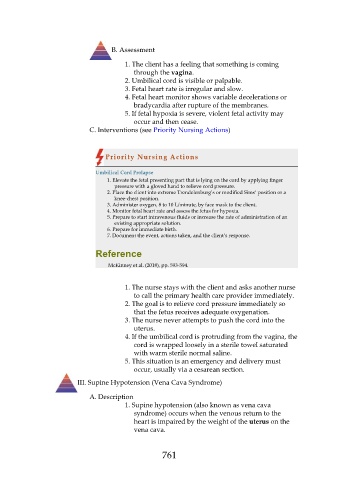Page 761 - Saunders Comprehensive Review For NCLEX-RN
P. 761
B. Assessment
1. The client has a feeling that something is coming
through the vagina.
2. Umbilical cord is visible or palpable.
3. Fetal heart rate is irregular and slow.
4. Fetal heart monitor shows variable decelerations or
bradycardia after rupture of the membranes.
5. If fetal hypoxia is severe, violent fetal activity may
occur and then cease.
C. Interventions (see Priority Nursing Actions)
Priority Nursing Actions
Umbilical Cord Prolapse
1. Elevate the fetal presenting part that is lying on the cord by applying finger
pressure with a gloved hand to relieve cord pressure.
2. Place the client into extreme Trendelenburg’s or modified Sims’ position or a
knee-chest position.
3. Administer oxygen, 8 to 10 L/minute, by face mask to the client.
4. Monitor fetal heart rate and assess the fetus for hypoxia.
5. Prepare to start intravenous fluids or increase the rate of administration of an
existing appropriate solution.
6. Prepare for immediate birth.
7. Document the event, actions taken, and the client’s response.
Reference
McKinney et al. (2018), pp. 593-594.
1. The nurse stays with the client and asks another nurse
to call the primary health care provider immediately.
2. The goal is to relieve cord pressure immediately so
that the fetus receives adequate oxygenation.
3. The nurse never attempts to push the cord into the
uterus.
4. If the umbilical cord is protruding from the vagina, the
cord is wrapped loosely in a sterile towel saturated
with warm sterile normal saline.
5. This situation is an emergency and delivery must
occur, usually via a cesarean section.
III. Supine Hypotension (Vena Cava Syndrome)
A. Description
1. Supine hypotension (also known as vena cava
syndrome) occurs when the venous return to the
heart is impaired by the weight of the uterus on the
vena cava.
761

